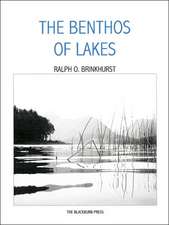Acetic Acid Bacteria: Ecology and Physiology
Editat de Kazunobu Matsushita, Hirohide Toyama, Naoto Tonouchi, Akiko Okamoto-Kainumaen Limba Engleză Hardback – 23 iun 2016
AAB research has a long history since the discovery of AAB by Louis Pasteur and the identification of AAB by Martinus Beijerinck in the nineteenth century. In the twentieth century, basic research on the taxonomic study of AAB and on biochemical study for the unique oxidative reactions of AAB had progressed as well as the industrial application of AAB not only in vinegar fermentation but also in the bioconversion process for useful chemical or pharmaceutical products. Entering the twenty-first century, AAB research has expanded more, and further progress is expected to be seen in all fields of AAB: classification and ecology, physiology and biochemistry, genetics, and biotechnology of vinegar fermentation and other oxidative fermentations. Far-reaching development in the last decade makes these bacteria more valuable for various industrial uses. Readers can obtain useful and comprehensive information which is exciting in aspects of basic science and provides hints for the better application of these bacteria to various kinds of practical production scenarios as well.
| Toate formatele și edițiile | Preț | Express |
|---|---|---|
| Paperback (1) | 1041.20 lei 38-44 zile | |
| Springer – 7 iun 2018 | 1041.20 lei 38-44 zile | |
| Hardback (1) | 1231.47 lei 3-5 săpt. | |
| Springer – 23 iun 2016 | 1231.47 lei 3-5 săpt. |
Preț: 1231.47 lei
Preț vechi: 1501.79 lei
-18% Nou
Puncte Express: 1847
Preț estimativ în valută:
235.66€ • 244.65$ • 196.51£
235.66€ • 244.65$ • 196.51£
Carte disponibilă
Livrare economică 04-18 martie
Preluare comenzi: 021 569.72.76
Specificații
ISBN-13: 9784431559313
ISBN-10: 4431559310
Pagini: 350
Ilustrații: VIII, 350 p. 68 illus., 46 illus. in color.
Dimensiuni: 155 x 235 x 25 mm
Greutate: 0.84 kg
Ediția:1st ed. 2016
Editura: Springer
Colecția Springer
Locul publicării:Tokyo, Japan
ISBN-10: 4431559310
Pagini: 350
Ilustrații: VIII, 350 p. 68 illus., 46 illus. in color.
Dimensiuni: 155 x 235 x 25 mm
Greutate: 0.84 kg
Ediția:1st ed. 2016
Editura: Springer
Colecția Springer
Locul publicării:Tokyo, Japan
Public țintă
ResearchCuprins
1 Systematics of acetic acid bacteria.- 2 Acetic acid bacteria in productions of vinegars and traditional fermented foods.- 3 Acetic acid bacteria in fermented food and beverage ecosystems.- 4 Acetic Acid Bacteria as Plant Growth Promoters.- 5 Acetic acid bacteria as symbionts of insects.- 6 Drosophila-Acetobacter as a model system for understanding animal-microbiota interactions.- 7 Distribution, evolution and physiology of oxidative fermentation.- 8 Physiology of Acetobacter spp.: Involvement of molecular chaperones during acetic acid fermentation.- 9 Physiology of Komagataeibacter spp. during acetic acid fermentation.- 10 Physiology of Acetobacter and Komagataeibacter spp.: Acetic acid resistance mechanism in acetic acid fermentation.- 11 Central carbon metabolism and respiration in Gluconobacter oxydans.- 12 Metabolic features of Acetobacter aceti.- 13 Membrane-bound dehydrogenases of acetic acid bacteria.- 14 Cellulose and other capsular polysaccharides of acetic acid bacteria.- 15 Industrial application of acetic acid bacteria (vitamin C & others).
Textul de pe ultima copertă
This book provides all facets of acetic acid bacteria (AAB) and offers the future targets and directions of AAB research. It summarizes the distinctive physiological properties of AAB and the recent progress on AAB study, especially in the following five areas: 1) Molecular phylogeny and genome study of AAB; 2) Ecological features of AAB: interaction with plants, natural fermentation systems, and insects; 3) Physiological features and living strategies of AAB, including rapid oxidation ability, acid resistance, biofilm formation, and genetic instability; 4) Molecular mechanisms of several oxidative fermentations such as acetate fermentation, sorbose fermentation, and ketogluconate fermentation; 5) Recent biotechnological aspects of AAB: biocatalysts, biosensors, biocellulose, and other useful polysaccharides.
AAB research has a long history since the discovery of AAB by Louis Pasteur and the identification of AAB by Martinus Beijerinck in the nineteenth century. In the twentieth century, basic research on the taxonomic study of AAB and on biochemical study for the unique oxidative reactions of AAB had progressed as well as the industrial application of AAB not only in vinegar fermentation but also in the bioconversion process for useful chemical or pharmaceutical products. Entering the twenty-first century, AAB research has expanded more, and further progress is expected to be seen in all fields of AAB: classification and ecology, physiology and biochemistry, genetics, and biotechnology of vinegar fermentation and other oxidative fermentations. Far-reaching development in the last decade makes these bacteria more valuable for various industrial uses. Readers can obtain useful and comprehensive information which is exciting in aspects of basic science and provides hints for the better application of these bacteria to various kinds of practical production scenarios as well.
AAB research has a long history since the discovery of AAB by Louis Pasteur and the identification of AAB by Martinus Beijerinck in the nineteenth century. In the twentieth century, basic research on the taxonomic study of AAB and on biochemical study for the unique oxidative reactions of AAB had progressed as well as the industrial application of AAB not only in vinegar fermentation but also in the bioconversion process for useful chemical or pharmaceutical products. Entering the twenty-first century, AAB research has expanded more, and further progress is expected to be seen in all fields of AAB: classification and ecology, physiology and biochemistry, genetics, and biotechnology of vinegar fermentation and other oxidative fermentations. Far-reaching development in the last decade makes these bacteria more valuable for various industrial uses. Readers can obtain useful and comprehensive information which is exciting in aspects of basic science and provides hints for the better application of these bacteria to various kinds of practical production scenarios as well.
Caracteristici
Summarizes up-to-date studies on acetic acid bacteria including all recent taxonomy changes Covers recent findings on the interaction of acetic acid bacteria and insects Presents almost all distinctive features of acetic acid bacteria including the molecular mechanism of acetic acid and other oxidative fermentations, and the other physiological and ecological aspects






















